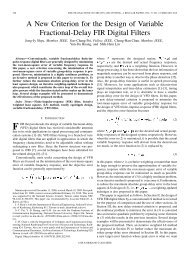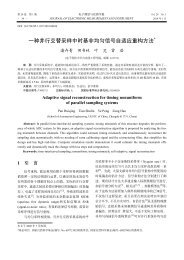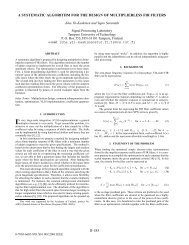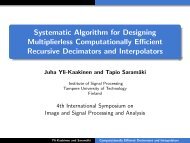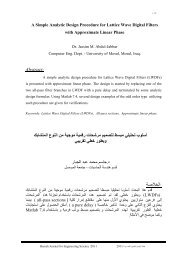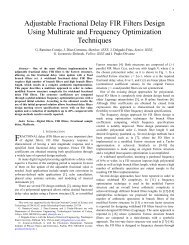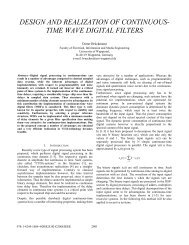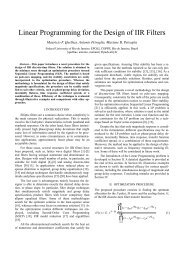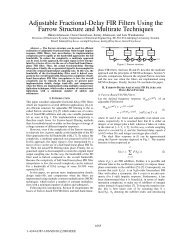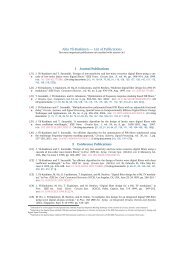Successive Approximation FIR Filter Design - UFRJ
Successive Approximation FIR Filter Design - UFRJ
Successive Approximation FIR Filter Design - UFRJ
You also want an ePaper? Increase the reach of your titles
YUMPU automatically turns print PDFs into web optimized ePapers that Google loves.
<strong>Successive</strong> <strong>Approximation</strong> <strong>FIR</strong> <strong>Filter</strong> <strong>Design</strong><br />
Alessandro J. S. Dutra<br />
Programa de Engenharia<br />
Elétrica – COPPE<br />
Univ. Federal do Rio de Janeiro<br />
a.dutra@ieee.org<br />
Lisandro Lovisolo<br />
Departamento de Eletrônica<br />
e Telecomunicações<br />
Univ. do Estado do Rio de Janeiro<br />
lisandro@uerj.br<br />
Eduardo A. B. da Silva and Paulo S. R. Diniz<br />
Programa de Engenharia Elétrica – COPPE<br />
Dept. de Eletrônica – POLI<br />
Univ. Federal do Rio de Janeiro<br />
eduardo@lps.ufrj.br, diniz@lps.ufrj.br<br />
Abstract—A new method for the design of finite impulse response<br />
(<strong>FIR</strong>) filters whose discrete coefficient space is the power-of-two space<br />
is presented. We employ a vector successive approximation technique<br />
successfully used in data compression algorithms to produce a design<br />
method with a very low computational complexity that generates filters<br />
with implementation cost as low as those obtained by other, much more<br />
complex, optimization methods.<br />
I. INTRODUCTION<br />
Thedesignof<strong>FIR</strong>filterswhosecoefficientsbelongtoaconstrained<br />
class of numbers (as opposed to using the full-precision floating-point<br />
numbers) has long been a subject of great interest. In particular, it<br />
is desired to design filters whose frequency responses match a set<br />
of previously defined specifications using word lengths as short as<br />
possible.<br />
A most useful outcome of such design philosophy is that of <strong>FIR</strong><br />
filters whose coefficients are made of sums of powers-of-two (POTs).<br />
This type of design proves to be most beneficial when dealing with<br />
hardware implementations, in which the use of general multipliers<br />
is very costly [1]. In this case, the use of POTs leads to what<br />
is commonly referred to as a “multiplier-less implementation, as<br />
each coefficient can be generated from a combination of shifts and<br />
adds/subtracts.<br />
In [2], [3], an integer programming approach is used to produce<br />
solutions to minimization problems using discrete constraints in the<br />
filter coefficient values for both the weighted minimax and weighted<br />
least-squares objective functions. In either case, the filter designs<br />
obtained are optimal for a given word length, but the design processes<br />
are extremely complex in computational terms. More recently, a<br />
method using linear programming to optimize the coefficients directly<br />
in the sub-expression space was proposed [4] that yields a<br />
considerable reduction in the number of required sums to attain a<br />
given specification.<br />
A different optimization approach is used in [5], in which an<br />
infinite-precision prototype filter is designed to exceed the project<br />
specifications, thereby producing a margin of error for the coefficient<br />
quantization. A non-linear optimization is then performed to determine<br />
the final filter representation.<br />
In this paper, we propose a design method also based on the<br />
approximation of a prototype filter, designed to match or exceed<br />
the project specifications, as needed. We employ a vector successive<br />
approximation technique initially developed for data compression<br />
applications, and define the representation dictionary in such a way<br />
that the design computational complexity is kept to a minimum.<br />
Thepaperisorganizedasfollows:SectionIIpresentsabriefreview<br />
of vector representation techniques, including the matching pursuits<br />
generalized bitplane (MPGBP) algorithm [6], which will serve as<br />
the basis for our proposed approximation method. The successive<br />
approximation design of <strong>FIR</strong> filters is then described in Section III,<br />
with examples and performance comparison against other existing<br />
1. Start with w = x, m = 1<br />
2. Repeat until a stop criterion is met:<br />
(a) Choose r m ∈ {1, . . . , q} such that<br />
(b) Choose<br />
w· v rm = max {w· vj}<br />
1≤j≤q<br />
k m =<br />
‰ ı log(w· vrm )<br />
log(α)<br />
where ⌈y⌉ is the smallest integer larger than or equal to y.<br />
(c) Replace w with w − α km v rm<br />
(d) Increment m.<br />
3. Stop.<br />
Figure 1. The MPGBP Algorithm [6]<br />
methods being discussed in Section IV. Our conclusions and future<br />
directions are then detailed in Section V.<br />
II. SUCCESSIVE APPROXIMATION OF VECTORS<br />
Several methods for the approximation of vectors have been<br />
successfully proposed for use in the image and video coding fields.<br />
The existence of particular constraining factors in those applications,<br />
such as the ever present trade-off on permissible encoding<br />
rate/reproduction quality, have led us to conjecture that the use of<br />
those algorithms for the task of approximating the coefficients of <strong>FIR</strong><br />
filters, where the main constraint lies on whether or not the filter’s<br />
frequency response satisfies the specifications, should enjoy similar<br />
success.<br />
One such approximation method is called matching pursuits with<br />
generalized bitplanes decomposition – the MPGBP algorithm [6]. It<br />
is a greedy algorithm in which a signal x is decomposed as<br />
x =<br />
∞X<br />
j=1<br />
X<br />
g ij,l<br />
(1)<br />
α j L j<br />
where g n ∈ D = {±g 1 , ±g 2 , . . . , ±g M } and 0 < α < 1.<br />
The MPGBP algorithm produces, after P passes, an approximation<br />
for x given by<br />
PX<br />
x (P) = α km v rm , (2)<br />
m=1<br />
where v rm ∈ D. The algorithm for performing such a decomposition<br />
is presented in Fig. 1.<br />
Assuming that ‖x‖ < 1, the error in the approximation is bounded<br />
by<br />
‖x − x (P) ‖ 2 ≤ β P<br />
where<br />
l=1<br />
β = p 1 − (2α − α 2 ) cos 2 (Θ(D))<br />
978-1-4244-9472-9/11/$26.00 ©2011 IEEE 149
and<br />
Θ(D) = cos −1 j<br />
min<br />
x∈R n j<br />
max<br />
g i ∈D<br />
„ «ffff x· gi<br />
,<br />
‖x‖ ‖g i ‖<br />
where x· g i denotes the inner product of the vectors x and g i .<br />
For 0 < α < 1 and Θ(D) < π/2, we have that β < 1 and<br />
therefore the representation error converges to zero as the number of<br />
approximation passes grows. Also, the smaller the value of Θ(D),<br />
the faster the convergence is.<br />
We shall now propose a modified version of the MPGBP algorithm<br />
to be used in the design of <strong>FIR</strong> filters.<br />
III. <strong>FIR</strong> FILTER APPROXIMATION<br />
Given a set of frequency response specifications {ω p, ω s, δ p, δ s},<br />
we use the Parks-McClellan algorithm [7] to design a order N<br />
prototype filter h(n), which will be represented as<br />
h = [h(0) h(1) . . . h(N)]. (3)<br />
In order to approximate the coefficients of h using a modified<br />
MPGBP algorithm, we first define the approximation dictionary<br />
D = {±g 1 , ±g 2 , . . . , ±g M }<br />
in which the codewords g i ∈ R N+1 and each codeword has P<br />
components with magnitude equal to 1 and (N +1−P) components<br />
equal to 0, i.e., they are permutations of the form<br />
g i = (±1 P , 0 (N+1−P) )<br />
The vector w is initialized with h and is then approximated using<br />
a version of the MPGBP algorithm (Fig. 1) in which the evaluation<br />
of k m in step 2.b is now given by<br />
k m = round<br />
„ log(w· vrm )<br />
log(α)<br />
«<br />
. (4)<br />
The search for v rm , which was an exhaustive one in the original<br />
method, can now be accomplished in a much faster way by taking<br />
into account the existing codeword structure. With that in mind, it<br />
suffices to sort the absolute values of the components of the current<br />
representation of w in decreasing order of magnitude and store the<br />
indices of the P largest ones. The approximation codeword v rm is<br />
then obtained by setting those P components whose indices were<br />
stored to ±1 according to the sign of w.<br />
Amongst the possible stop criteria for use with the design<br />
method one may cite the approximation error and the number of<br />
adds/subtracts used in the approximation.<br />
The search for the best approximation with the proposed method<br />
includes testing for prototypes of different orders N – starting with<br />
the minimum required by the Parks-McClellan algorithm to meet the<br />
filter specifications – and for different values of P, the number of<br />
non-zero codeword components, and look for the one that yields the<br />
lowest implementation complexity, in terms of number of adders used<br />
by the filter.<br />
It is also worth noticing that the number of POTs used in the<br />
approximation of distinct components is not fixed, a constraint found<br />
in other optimization methods. For each design, a global output<br />
multiplier is determined to ensure that the average passband gain<br />
is kept at 0 dB.<br />
IV. EXPERIMENTAL RESULTS<br />
In this section we present the performance of the proposed algorithm<br />
by comparing it against that of other methods in the literature.<br />
Table I<br />
LOWEST COMPLEXITY IMPLEMENTATION PARAMETERS OBTAINED WITH<br />
THE SA-DESIGN METHOD FOR SPECIFICATIONS OF EXAMPLE 1.<br />
P N POTs Adders<br />
5 33 11 33<br />
4 29 11 30<br />
3 33 11 31<br />
2 29 11 30<br />
1 33 12 33<br />
Table II<br />
COEFFICIENTS FOR THE SA-DESIGNED <strong>FIR</strong> FILTER OF EXAMPLE 1.<br />
(P = 4, N = 29, h(29−n) = h(n) for n = 0, . . . , 14)<br />
n h(n) POTs used in approximation<br />
0 -0.00097656250 −2 −10<br />
1 -0.00341796875 −2 −8 + 2 −11<br />
2 0.00000000000 0<br />
3 0.00683593750 2 −7 − 2 −10<br />
4 0.00585937500 2 −7 − 2 −9<br />
5 -0.00830078125 −2 −7 − 2 −11<br />
6 -0.01757812500 −2 −6 − 2 −9<br />
7 0.00000000000 0<br />
8 0.03173828125 2 −5 + 2 −11<br />
9 0.02539062500 2 −5 − 2 −7 − 2 −9<br />
10 -0.03515625000 −2 −5 − 2 −8<br />
11 -0.07714843750 −2 −4 − 2 −6 + 2 −10<br />
12 0.00048828125 2 −11<br />
13 0.19824218750 2 −2 − 2 −4 − 2 −7 + 2 −8 − 2 −10<br />
14 0.37304687500 2 −1 − 2 −3 + 2 −9<br />
A. Example 1<br />
The specifications are those of [5], Ex. 1. A low-pass filter design<br />
is desired in which the passband and stopband edges are located at<br />
w p = 0.3π and w s = 0.5π and the maximum allowed passband and<br />
stopband ripples are δ p = δ s = 0.00316, corresponding to a 50 dB<br />
stopband attenuation.<br />
For the prototype design, the minimum order leading to a design<br />
attaining the specifications is determined to be N min = 25. We<br />
employ the design method for values of P ∈ {1, 2, 3, 4, 5} and order<br />
up to N = 35, searching for the minimum complexity (in number of<br />
adders) implementation.<br />
The best results presented in [5] indicate that the specifications<br />
can be attained by using a N = 29 order filter, with 37 adders.<br />
The number of adders, however, may be lowered to 30 by using a<br />
common sub-expression elimination post-design method. As can be<br />
seen from Table I, these numbers are matched with the design based<br />
on the dictionary with P = 4. The amplitude response for this filter,<br />
along with its passband details, can be seen in Fig. 2. The impulse<br />
response of this particular filter is described in Table II.<br />
B. Example 2<br />
The specifications are those of [5], Ex. 2. A low-pass filter design<br />
is desired in which the passband and stopband edges are located at<br />
w p = 0.3π and w s = 0.5π and the maximum allowed passband<br />
and stopband ripples are δ p = δ s = 0.001, corresponding to a 60 dB<br />
stopband attenuation.<br />
For the prototype design, the minimum order leading to a design<br />
attaining the specifications is determined to be N min = 32. We<br />
employ the design method for values of P ∈ {1, 2, 3, 4, 5, 6} and<br />
order up to N = 42, searching for the minimum complexity (in<br />
number of adders) implementation.<br />
150
20<br />
<strong>Filter</strong> Order: 29<br />
Prototype<br />
SA−design<br />
20<br />
<strong>Filter</strong> Order: 39<br />
Prototype<br />
SA−design<br />
0<br />
0<br />
−20<br />
−20<br />
Amplitude in dB<br />
−40<br />
Amplitude in dB<br />
−40<br />
−60<br />
−60<br />
−80<br />
−80<br />
−100<br />
0 0.1 0.2 0.3 0.4 0.5 0.6 0.7 0.8 0.9 1<br />
ω/π<br />
−100<br />
0 0.1 0.2 0.3 0.4 0.5 0.6 0.7 0.8 0.9 1<br />
ω/π<br />
<strong>Filter</strong> Order: 29<br />
<strong>Filter</strong> Order: 39<br />
0.08<br />
0.06<br />
Prototype<br />
SA−design<br />
0.08<br />
0.06<br />
Prototype<br />
SA−design<br />
0.04<br />
0.04<br />
Amplitude in dB<br />
0.02<br />
0<br />
−0.02<br />
Amplitude in dB<br />
0.02<br />
0<br />
−0.02<br />
−0.04<br />
−0.04<br />
−0.06<br />
−0.06<br />
−0.08<br />
0 0.05 0.1 0.15 0.2 0.25 0.3<br />
ω/π<br />
−0.08<br />
0 0.05 0.1 0.15 0.2 0.25 0.3<br />
ω/π<br />
Figure 2. Magnitude responses for the prototype and the SA-designed <strong>FIR</strong><br />
filters (P = 4) in Example 1. (Passband detail shown separately)<br />
Figure 3. Magnitude responses for the prototype and the SA-designed <strong>FIR</strong><br />
filters (P = 3) in Example 2. (Passband detail shown separately)<br />
Table III<br />
LOWEST COMPLEXITY IMPLEMENTATION PARAMETERS OBTAINED WITH<br />
THE SA-DESIGN METHOD FOR SPECIFICATIONS OF EXAMPLE 2.<br />
P N POTs Adders<br />
6 37 13 49<br />
5 37 13 50<br />
4 38 13 50<br />
3 39 13 48<br />
2 37 13 48<br />
1 37 13 48<br />
In this more restrictive case, the best results presented in [5]<br />
indicate that the specifications can be attained by using a N = 37<br />
order filter, with 48 adders. Once again the number of adders may<br />
be lowered to 39 by using a common sub-expression elimination<br />
post-design method. As can be seen from Table III, the numbers<br />
obtained with the SA-design based on the dictionary with P = 4<br />
are comparable to those of [5] without the post-processing step. The<br />
amplitude response for this filter, along with its passband details, can<br />
be seen in Fig. 3.<br />
C. Example 3<br />
As a third example, we propose the design of a band-pass filter<br />
whose specifications are as follows:<br />
- passband edges: w p1 = 0.3π, w p2 = 0.6π<br />
- stopband edges: w s1 = 0.15π, w s2 = 0.8π<br />
and the maximum allowed passband and stopband ripples are δ p =<br />
δ s1 = δ s2 = 0.001, corresponding to a 60 dB stopband attenuation.<br />
For the prototype design, the minimum order leading to a design<br />
attaining the specifications is determined to be N min = 43. We<br />
employ the design method for values of P ∈ {1, 2, 3, 4, 5, 6, 7} and<br />
order up to N = 63, searching for the minimum complexity (in<br />
number of adders) implementation.<br />
In this case, the prototype design method determined that the<br />
minimum order so that the specifications may be attained is N = 43.<br />
The lowest-complexity implementation is obtained by setting P = 1<br />
and designing an N = 55 order filter. For that design, whose<br />
coefficientsarepresentedinTableV,thenumberofrequiredaddersis<br />
67, with the use of 12 different power-of-two factors. The amplitude<br />
response for this filter, along with its passband details, can be seen<br />
in Fig. 4.<br />
151
Table IV<br />
LOWEST COMPLEXITY IMPLEMENTATION PARAMETERS OBTAINED WITH<br />
THE SA-DESIGN METHOD FOR SPECIFICATIONS OF EXAMPLE 3.<br />
Amplitude in dB<br />
Amplitude in dB<br />
20<br />
0<br />
−20<br />
−40<br />
−60<br />
−80<br />
P N POTs Adders<br />
7 61 12 72<br />
6 61 12 74<br />
5 62 11 73<br />
4 53 12 76<br />
3 62 11 73<br />
2 55 13 74<br />
1 55 12 67<br />
<strong>Filter</strong> Order: 55<br />
Prototype<br />
SA−design<br />
−100<br />
0 0.1 0.2 0.3 0.4 0.5 0.6 0.7 0.8 0.9 1<br />
ω/π<br />
0.08<br />
0.06<br />
0.04<br />
0.02<br />
0<br />
−0.02<br />
−0.04<br />
−0.06<br />
−0.08<br />
<strong>Filter</strong> Order: 55<br />
Prototype<br />
SA−design<br />
0.3 0.35 0.4 0.45 0.5 0.55 0.6<br />
ω/π<br />
Figure 4. Magnitude responses for the prototype and the SA-designed <strong>FIR</strong><br />
filters (P = 1) in Example 3. (Passband detail shown separately)<br />
V. CONCLUSIONS<br />
We have presented a novel method for the design of <strong>FIR</strong> digital<br />
filters based on the successive approximation of vectors in which<br />
the components are approximated by sums of powers-of-two. The<br />
proposed method produces approximations of the impulse response<br />
of a given filter with very low implementation complexity, without<br />
resorting to costly optimization techniques.<br />
The obtained results show the potential of the proposed method,<br />
and indicate there may still be room left for improvement by, for<br />
instance, employing adaptive dictionaries in the approximation step.<br />
Table V<br />
COEFFICIENTS FOR THE SA-DESIGNED <strong>FIR</strong> FILTER OF EXAMPLE 3.<br />
(P = 1, N = 55, h(55−n) = h(n) for n = 0, . . . , 27)<br />
n h(n) POTs used in approximation<br />
0 -0.000732421875 −2 −10 + 2 −12<br />
1 0.000488281250 2 −11<br />
2 0.000732421875 2 −10 − 2 −12<br />
3 -0.000732421875 −2 −10 + 2 −12<br />
4 0.002929687500 2 −8 − 2 −10<br />
5 0.000488281250 2 −11<br />
6 -0.004150390625 −2 −8 − 2 −12<br />
7 0.002441406250 2 −9 + 2 −11<br />
8 -0.005371093750 −2 −8 − 2 −9 + 2 −11<br />
9 -0.007324218750 −2 −7 + 2 −11<br />
10 0.010742187500 2 −7 + 2 −8 − 2 −10<br />
11 -0.001953125000 −2 −9<br />
12 0.003906250000 2 −8<br />
13 0.023437500000 2 −5 − 2 −7<br />
14 -0.014404296875 −2 −6 + 2 −10 − 2 −12<br />
15 -0.006347656250 −2 −7 + 2 −9 + 2 −11<br />
16 0.003662109375 2 −8 − 2 −12<br />
17 -0.047363281250 −2 −4 + 2 −6 + 2 −11<br />
18 0.003906250000 2 −8<br />
19 0.024414062500 2 −5 − 2 −7 − 2 −10<br />
20 -0.014648437500 −2 −6 + 2 −10<br />
21 0.081542968750 2 −4 + 2 −6 + 2 −8 − 2 −11<br />
22 0.035156250000 2 −5 + 2 −8<br />
23 -0.052490234375 −2 −4 + 2 −7 − 2 −9 − 2 −12<br />
24 0.038574218750 2 −5 + 2 −7 − 2 −11<br />
25 -0.189453125000 −2 −2 + 2 −4 + 2 −9<br />
26 -0.247070312500 −2 −1 + 2 −8 + 2 −10<br />
27 0.360107421875 2 −1 − 2 −3 + 2 −6 − 2 −10 − 2 −12<br />
REFERENCES<br />
[1] J. Yli-Kaakinen and T. Saramaki, “A systematic algorithm for the design<br />
of lattice wave digital filters with short-coefficient wordlength,” Circuits<br />
and Systems I: Regular Papers, IEEE Transactions on, vol. 54, pp. 1838–<br />
1851, aug. 2007.<br />
[2] Y. C. Lim, S. Parker, and A. Constantinides, “Finite word length <strong>FIR</strong><br />
filter design using integer programming over a discrete coefficient space,”<br />
Acoustics, Speech and Signal Processing, IEEE Transactions on, vol. 30,<br />
pp. 661–664, aug 1982.<br />
[3] Y. C. Lim and S. Parker, “<strong>FIR</strong> filter design over a discrete powers-oftwo<br />
coefficient space,” Acoustics, Speech and Signal Processing, IEEE<br />
Transactions on, vol. 31, pp. 583–591, jun 1983.<br />
[4] Y. J. Yu and Y. C. Lim, “<strong>Design</strong> of linear phase <strong>FIR</strong> filters in subexpression<br />
space using mixed integer linear programming,” Circuits and Systems<br />
I: Regular Papers, IEEE Transactions on, vol. 54, pp. 2330–2338, oct.<br />
2007.<br />
[5] J. Yli-Kaakinen and T. Saramaki, “A systematic algorithm for the design<br />
of multiplierless <strong>FIR</strong> filters,” in Circuits and Systems, 2001. ISCAS 2001.<br />
The 2001 IEEE International Symposium on, vol. 2, pp. 185–188 vol. 2,<br />
6-9 2001.<br />
[6] R. Caetano, E. A. B. da Silva, and A. G. Ciancio, “Video coding using<br />
greedy decompositions on generalised bit-planes,” Electronics Letters,<br />
vol. 38, pp. 507–508, 2002.<br />
[7] P. S. R. Diniz, E. A. B. da Silva, and S. L. Netto, Digital Signal<br />
Processing: System Analysis and <strong>Design</strong>. Cambridge University Press,<br />
2nd ed., 2010.<br />
152



